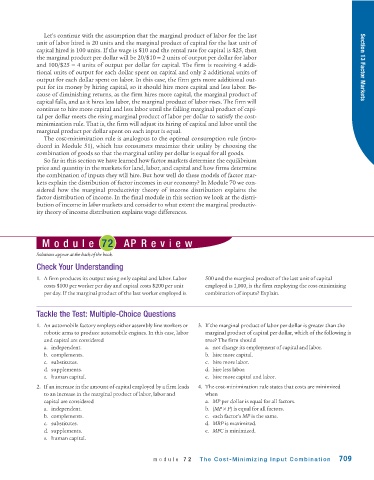Page 751 - Krugmans Economics for AP Text Book_Neat
P. 751
Let’s continue with the assumption that the marginal product of labor for the last
unit of labor hired is 20 units and the marginal product of capital for the last unit of
capital hired is 100 units. If the wage is $10 and the rental rate for capital is $25, then
the marginal product per dollar will be 20/$10 = 2 units of output per dollar for labor
and 100/$25 = 4 units of output per dollar for capital. The firm is receiving 4 addi- Section 13 Factor Markets
tional units of output for each dollar spent on capital and only 2 additional units of
output for each dollar spent on labor. In this case, the firm gets more additional out-
put for its money by hiring capital, so it should hire more capital and less labor. Be-
cause of diminishing returns, as the firm hires more capital, the marginal product of
capital falls, and as it hires less labor, the marginal product of labor rises. The firm will
continue to hire more capital and less labor until the falling marginal product of capi-
tal per dollar meets the rising marginal product of labor per dollar to satisfy the cost-
minimization rule. That is, the firm will adjust its hiring of capital and labor until the
marginal product per dollar spent on each input is equal.
The cost-minimization rule is analogous to the optimal consumption rule (intro-
duced in Module 51), which has consumers maximize their utility by choosing the
combination of goods so that the marginal utility per dollar is equal for all goods.
So far in this section we have learned how factor markets determine the equilibrium
price and quantity in the markets for land, labor, and capital and how firms determine
the combination of inputs they will hire. But how well do these models of factor mar-
kets explain the distribution of factor incomes in our economy? In Module 70 we con-
sidered how the marginal productivity theory of income distribution explains the
factor distribution of income. In the final module in this section we look at the distri-
bution of income in labor markets and consider to what extent the marginal productiv-
ity theory of income distribution explains wage differences.
Module 72 AP Review
Solutions appear at the back of the book.
Check Your Understanding
1. A firm produces its output using only capital and labor. Labor 500 and the marginal product of the last unit of capital
costs $100 per worker per day and capital costs $200 per unit employed is 1,000, is the firm employing the cost-minimizing
per day. If the marginal product of the last worker employed is combination of inputs? Explain.
Tackle the Test: Multiple-Choice Questions
1. An automobile factory employs either assembly line workers or 3. If the marginal product of labor per dollar is greater than the
robotic arms to produce automobile engines. In this case, labor marginal product of capital per dollar, which of the following is
and capital are considered true? The firm should
a. independent. a. not change its employment of capital and labor.
b. complements. b. hire more capital.
c. substitutes. c. hire more labor.
d. supplements. d. hire less labor.
e. human capital. e. hire more capital and labor.
2. If an increase in the amount of capital employed by a firm leads 4. The cost-minimization rule states that costs are minimized
to an increase in the marginal product of labor, labor and when
capital are considered a. MP per dollar is equal for all factors.
a. independent. b. (MP × P) is equal for all factors.
b. complements. c. each factor’s MP is the same.
c. substitutes. d. MRP is maximized.
d. supplements. e. MFC is minimized.
e. human capital.
module 72 The Cost-Minimizing Input Combination 709

